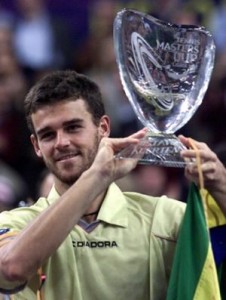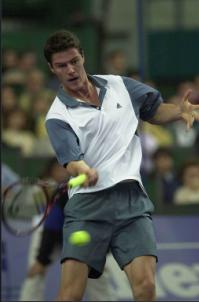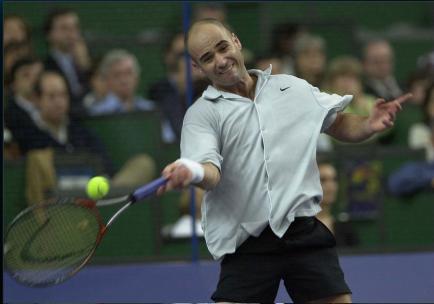With the World Tour Finals out of the way for another season, the time seems apposite to travel back a decade to the first Tennis Masters Cup, which remains one of the finest season finales ever contested.
Tennis Masters Cup, 2000
 The inaugural Tennis Masters Cup took place in Lisbon, Portugal in late November 2000. Heavily promoted as the ecstatic endpoint of the exciting, new and now-eclipsed ATP Champion’s Race, it remains the best Year End Championships I’ve ever seen, courtesy of a strong field, an involved and boisterous crowd, high stakes, and a transcendent performance from the universally loved and gravely-missed Gustavo Kuerten.
The inaugural Tennis Masters Cup took place in Lisbon, Portugal in late November 2000. Heavily promoted as the ecstatic endpoint of the exciting, new and now-eclipsed ATP Champion’s Race, it remains the best Year End Championships I’ve ever seen, courtesy of a strong field, an involved and boisterous crowd, high stakes, and a transcendent performance from the universally loved and gravely-missed Gustavo Kuerten.
It is as convenient as it was unlikely that the first season of the new millennium would so perfectly demonstrate a radical shift in eras. But if ever that hackneyed show-tune ‘Changing of the Guard’ could be induced to sing, it was here, molto cantabile. The field in Lisbon showcased it perfectly:
- Marat Safin
- Gustavo Kuerten
- Pete Sampras
- Magnus Norman
- Yevgeny Kafelnikov
- Andre Agassi
- Lleyton Hewitt
- Alex Corretja
Four old, four new. The four majors (held by Agassi, Kuerten, Sampras and Safin; again an even split) had produced some stunning variations on the theme, reaching a climactic fanfare in Sampras’ abject flogging at the hands of Safin in New York some months before. The Masters Cup was merely the Coda, although, as the Eroica proved, Codas can have developments all their own.
 Vigorous counterpoint came in the form of the year end No.1 ranking, floating melismatically over proceedings, before revealing itself to be the true theme as the going got serious. The top spot was held gingerly by Safin, courtesy of a dramatic win at the Paris Indoors. Both Sampras and Kuerten had the slimmest of chances to steal it from him, but as the week wore on the number of cards that had to fall the Brazilian’s way began to stack ever higher, forming an improbably teetering edifice. As ever, there were multitude permutations at play, but the main thing to know was that Safin would be guaranteed the No.1 ranking if he beat Agassi in the semifinal. Meanwhile, Kuerten could steal it from him if Safin failed to make the final, and if he (Kuerten) won the event, which would require beating Sampras and Agassi back-to-back. The key statistic here is that no one had ever beaten Sampras and Agassi back-to-back in the same tournament. Ever.
Vigorous counterpoint came in the form of the year end No.1 ranking, floating melismatically over proceedings, before revealing itself to be the true theme as the going got serious. The top spot was held gingerly by Safin, courtesy of a dramatic win at the Paris Indoors. Both Sampras and Kuerten had the slimmest of chances to steal it from him, but as the week wore on the number of cards that had to fall the Brazilian’s way began to stack ever higher, forming an improbably teetering edifice. As ever, there were multitude permutations at play, but the main thing to know was that Safin would be guaranteed the No.1 ranking if he beat Agassi in the semifinal. Meanwhile, Kuerten could steal it from him if Safin failed to make the final, and if he (Kuerten) won the event, which would require beating Sampras and Agassi back-to-back. The key statistic here is that no one had ever beaten Sampras and Agassi back-to-back in the same tournament. Ever.
Then as now, the real show began once the round robin stage was mostly done with, although the final Group A encounter between Sampras and Safin – who to casual fans still appeared to be some kind of terrifying Soviet tennis robot from the future – boasted all the focussed interest of the revenge-match. Pistol Pete was a proud man, and New York had been humiliating. It unfolded like this:
Sampras, as was his way, tore Safin to shreds in the final round robin match, 3 and 2. In the semifinal, Agassi did much the same, 3 and 3. Safin was no longer guaranteed the No.1 ranking, but could only lose it if Kuerten overcame Sampras and Agassi on a fast indoor hardcourt. No pressure. The semifinal between Kuerten and Sampras was the first meeting between the pair since their dramatic and excellent Miami final many months before, and this encounter eclipsed it in almost every way (it wasn’t as brutally warm, and Sampras had marginally less support). Deep in the final set, Kuerten held his nerve to break the man he regarded as the best player ever and move within a match of achieving the unthinkable.
 For most of the year, Andre Agassi had been the man to beat, and between the Australian Open and the Tennis Masters Cup, just about everyone did. In January he’d completed the most successful nine months since Rod Laver, with titles at the French, US and Australian Opens, and finalist at Wimbledon and the Tour Championships. In doing so, he had completed the transition from feckless wastrel to the Agassi the world now remembers: eerily gracious and terrifyingly consistent. Still, it had since been a disappointing year for the Las Vegan, but he was back on song in Lisbon, and moved into the final with a perfect 4-0 record, a single dropped set the only discordant note.
For most of the year, Andre Agassi had been the man to beat, and between the Australian Open and the Tennis Masters Cup, just about everyone did. In January he’d completed the most successful nine months since Rod Laver, with titles at the French, US and Australian Opens, and finalist at Wimbledon and the Tour Championships. In doing so, he had completed the transition from feckless wastrel to the Agassi the world now remembers: eerily gracious and terrifyingly consistent. Still, it had since been a disappointing year for the Las Vegan, but he was back on song in Lisbon, and moved into the final with a perfect 4-0 record, a single dropped set the only discordant note.
Three memories from the final remain clear:
- Kuerten blowing out one of his sneakers in the first set, and the inordinate delay as Larry Passos scuttled off to find or buy a new pair. Agassi had once suffered a similar misfortune in Germany, and had had to borrow shoes from someone in the crowd. He was quite patient.
- Kuerten almost blowing his stack upon being foot-faulted, roundly abusing the linesperson for a few points to go down 15-40, before finally regrouping and ekeing out a hold. It is a useful corrective to the now-established view that he was always placid to the point of saintliness.
- The backhand. Has there ever been a smoother stroke than Gustavo Kuerten’s backhand? It’s like silk drizzled with melted butter, then marinated in a 21-year-old single malt. It might even be more delicious than that. Agassi was clearly terrified of it. The key moment comes with Kuerten receiving at 2/2 in the third, when the Brazilian tears the match away with a ferocious backhand barrage. Winner up the line, inside-out backhand winner, ripping return at Agassi’s feet. Then at 15-40, a flak-happy Agassi is forced to direct his second serve to the Kuerten forehand, or at least away from the backhand. That serve is not in the American’s repertoire, and he duly double-faults. That’s the break, the match, the title.
It was also the year end No.1 ranking, to date the only time a South American has achieved it. Watching the match again, especially Kuerten’s post-match interview, I doubt I’ve ever felt more melancholy in the presence of such unrestrained joy. Kuerten’s pleasure at his win is so pure, so unabashed, and (in hindsight) in such contrast to the sadly abbreviated course his career was to take. His dominance was to last another 10 or so months – he would claim his third French Open the following May – until a seemingly innocuous hip injury would reduce this most humble and generous of champions to the status of occasional sideshow. Meanwhile, Safin would never again threaten for the year end No.1 ranking. Guga’s hip and Marat’s head . . . the two factors denying the world a truly great rivalry, one that might have sustained us through the lean years ahead.
It wasn’t to be. For all its drama and promise – its sound and fury – the 2000 Tennis Masters Cup signified little. It was the gentlest suggestion of what might have been, when a willowy Brazilian with a devastating backhand and an infectious smile momentarily ruled the world.
The final (Kuerten vs. Agassi) can be downloaded in full here. The semifinal (Kuerten vs. Sampras) can be downloaded here. As ever, please avoid highlights were possible.

One Response to The Hip and The Head